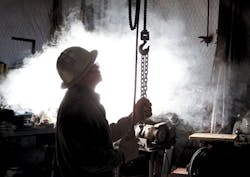Technically Innovative, Market-Savvy Machine Builders Will Thrive
“However, the recent economic downturn hit the discrete manufacturing industries particularly hard, placing enormous business pressure on the OEM (original equipment manufacturer) machine tool builders that serve these industries.”
Some pressure arises because engineering design processes need retooling. “While some machine builders have adopted informal concurrent engineering methods, more often they rely on individual skill sets and established practices and knowledge that have been developed and passed down over decades,” Spada observes. That doesn’t work well now, he says, “because as the complexity of the machine requirements increase and design teams reach a threshold in numbers, those informal concurrent engineering processes break down.” And that means, he says, that design constraints imposed within one engineering group are easily overlooked by others because no common functional model exists.
Spada believes that the emergence of next-generation development platforms and state-of-the-art simulation technology will help address these challenges. He notes that development environments using a common framework for systems engineering, functional modeling and advanced simulation technologies will assist this process. “These model-based design concepts have been well proven in other industries, where embedded software and mechatronic systems converge. It’s time for the machine tool industry to adopt them as well.”
Maybe industry has gotten the message? “Mechatronics machine design was a visible trend at Pack Expo International 2010 [last November], where [Arlington, Va.-based] PMMI (Packaging Machinery Manufacturers Institute, www.pmmi.org) launched its new mechatronics training program,” says Sandy Holden, market development manager, OEM, for supplier Rockwell Automation Inc. (www.rockwellautomation.com), Milwaukee. He explains that mechatronics—the combination of mechanical, electrical and control engineering—is a collaborative interdisciplinary machine-design approach that, to achieve fast time-to-market for products, helps machine builders bring engineering processes closer together.
Robotics penetration
Pack Expo 2010 also revealed a noticeable increase in robotic applications—particularly, integrated robotic control—from the previous year’s show, Holden observes. “An integrated robotic solution offers an open-architecture system with one programming environment and one programmable automation controller (PAC) for the entire machine control,” he explains. Among technology displayed at the exposition was a Kuka PA Robot Arm integrated directly to a Rockwell-manufactured Allen-Bradley PAC, he says. The robotic cell was displayed with an integrated system of product and case conveyors, end-of-arm tooling, tool changing, pattern forming and case top loading, he adds.
“We see new [robotics] users in every industry with applications that were not automatable before, simply due to cost,” notes Pete Squires, vice president of controls for packaging machine supplier Schneider Packaging Equipment Co. Inc. (www.schneiderequip.com), Brewerton, N.Y. Some applications include robotic palletizing of truck brake parts, high-speed raw-food handling, loading a flow wrapper (candy) or snack-size bags into cartons, and everything in between, he says. “Every week, we see several new opportunities.” He emphasizes that robotic solutions eliminate traditional hard automation, thus simplifying systems. That means fewer bearings, sensors, solenoids, cylinders, servos and the like that were once used to perform product orientation, sorting, stacking, pick-and-place and other operations, Squires remarks.
Related Content – Pack Expo 2010: News and Product Announcements
To read, visit http://www.automationworld.com/news-7793
Regardless of past or future technical advances, though, “the machine tool business is ramping up now, and since about July 2010, is having a fabulous year,” Spada says. But the real current need of the machine tool builders is improving efficiencies and design tools, he believes.
Simultaneously, the market forces machine builders to take on more responsibilities, Spada says. “The customers have displaced—outsourced—their engineering staffs to their supply chains.” Thus, machine builders are being asked to not only design machines, but also to support their end-users’ processes through problem solving once assigned to internal engineering staffs.
Shrinking corporate engineering staffs, coupled with more pressure to bring systems online quickly also means that end-users rely on machine builders to deliver machines that integrate seamlessly with existing systems, Holden observes. He thinks EtherNet/IP, an industrial Ethernet protocol promulgated by ODVA (formerly known as the Open DeviceNet Vendors Association, www.odva.org) is the best pathway to a converged network architecture that will help with this demand. It’ll do so by simplifying control and information flow from the machine to the end-users’ manufacturing information-technology enterprise, he explains.
Schneider Packaging sees end-users ramping up now, but with fewer staff, Squires adds. Simultaneously, “they are demanding much more for much less cost. This is driving innovative solutions that, in turn, feed the adoption cycle of robotic solutions.” For machine builders that are innovative with technology solutions and the ability to market in different industries, “they will gain a larger share of the market and grow faster than the economy,” he predicts. Put another way: They’ll thrive.
C. Kenna Amos, [email protected], is an Automation World Contributing Editor.
Subscribe to Automation World's RSS Feeds for Columns & Departments
About the Author
C. Kenna Amos
Contributing Editor

Leaders relevant to this article:
